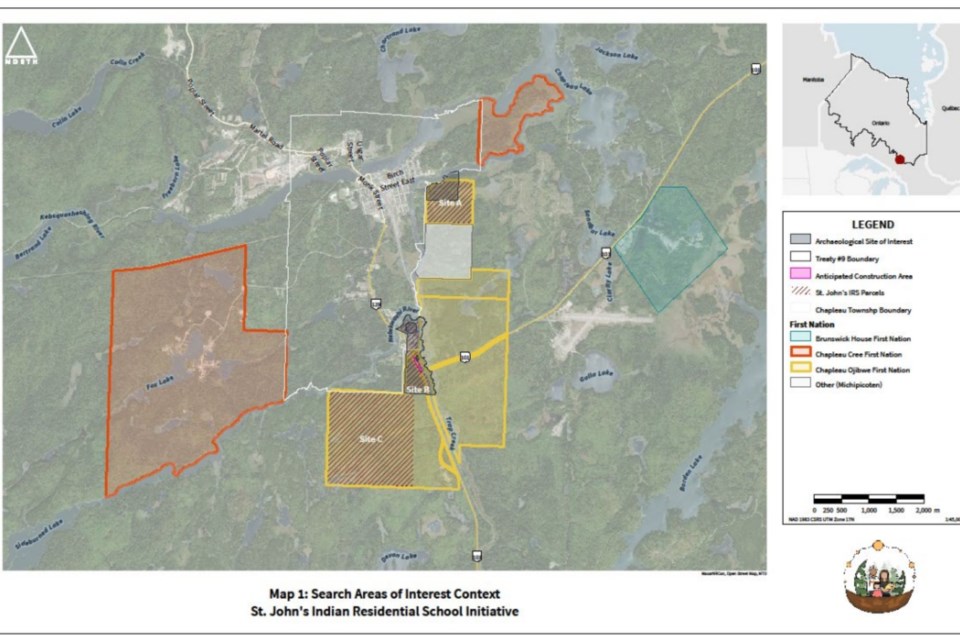CHAPLEAU — Members of three First Nations are working together to investigate the grounds of the former St. John’s Residential School east of Wawa.
From Aug. 1 to 3, historic human remains detection dogs will comb through heavily overgrown areas near the site slightly southeast of Chapleau. The search is part of an ongoing initiative led by survivors and supported by Chapleau Cree First Nation, Chapleau Ojibwe First Nation, and Brunswick House First Nation.
“We’re mostly led by the survivors group, which we call the survivors working circle,” said Deanna Dixon, residential school initiative lead for Chapleau Cree First Nation.
“It also includes intergenerational survivors, but we're also led by our communities and our respective chief and councils as well.”
Dixon said work began with research and protocols in 2023, followed by on-the-ground search activities starting in 2024. The team has since employed a layered, non-invasive approach combining drone-based LiDAR, ground-penetrating radar, multispectral imaging, and now, detection dogs.
“The (historic human remains detection dogs are) another highly sought method because they can detect human remains historically, up to over 150 years,” she said.
“That was of particular interest to us because of the timeline of when St. John's had existed.”
There are two known sites: the first operated from 1907 to 1919 slightly southeast from the Township of Chapleau (Site A), and the second from 1920 to 1948 south of the township (Site B). Due to dense tree cover and natural overgrowth, using radar at the first location proved difficult. That's where the historic human remains detection dogs come in.

“At the first site, we're using the (historic human remains detection) dogs because it's really overgrown,” said Adrienne Beaupre, the initiative’s community coordinator.
“It isn't beneficial to use the GPR there when there's large tree growth and stumps and because it's been so long. It's more appropriate to use them on the first site to help us find and hone in on these points of interest.”
The work is personal for both women. For both women, the work is deeply personal.
“My grandfather, Michael Cachagee, was a pretty well-known residential school advocate… He attended three schools, including Shingwauk, Bishop Horden Hall and St. John's,” said Dixon.
“When our initiative began, he had already passed. So to be able to do this work is also to recognize that this work didn’t start with us. It’s been going on since those survivors were no longer students anymore.”

Beaupre’s grandfather attended both sites.
“He spoke of digging graves when he was just a boy,” Beaupre said.
“Three of my mom's sisters never made it back from St. John's, this one here in Chapleau. And my mother attended the one in Sault Ste. Marie … Everyone has been affected.”
Though no confirmed findings have been announced, the team has completed reconnaissance surveys and layered historic maps with present-day imagery to better locate buildings and landmarks. They're also working closely with the National Centre for Truth and Reconciliation and Carleton University to access and interpret records.
“We’ve done community engagement sessions … Because, of course, this is a whole new field of knowledge to learn and share,” said Dixon.
“As Indigenous people, archaeology and things like that can be very triggering. But we've also used very non-invasive processes, and we will continue to.”
Cultural and mental health supports have been built into every step of the initiative.
“We’ve always tried to use a myriad of support,” said Dixon.
“Just like we're doing with the searches, we always try and layer cultural and mental health support… People ask, ‘Why now?’ I think the work was always ongoing, it's just now technology is finally starting to catch up to some of the questions that we have. Not all of them, but some of them.”
